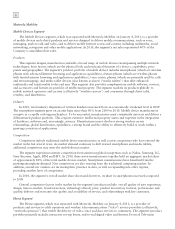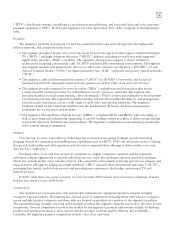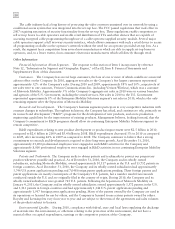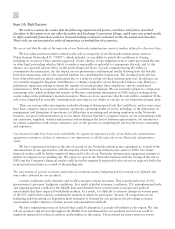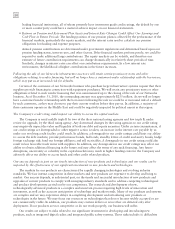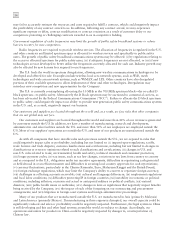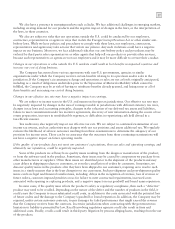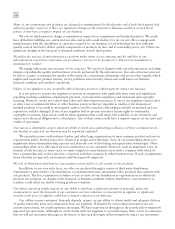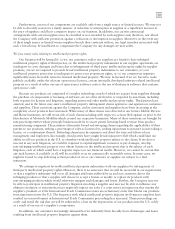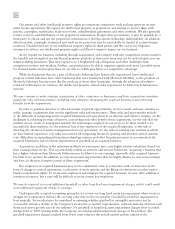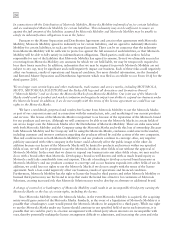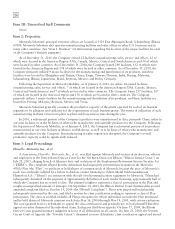Motorola 2010 Annual Report Download - page 24
Download and view the complete annual report
Please find page 24 of the 2010 Motorola annual report below. You can navigate through the pages in the report by either clicking on the pages listed below, or by using the keyword search tool below to find specific information within the annual report.
16
may fail to accurately estimate the resources and costs required to fulfill a contract, which could negatively impact
the profitability of any contract award to us. In addition, following any contract award, we may experience
significant expense or delay, contract modification or contract rescission as a result of customer delay or our
competitors protesting or challenging contracts awarded to us in competitive bidding.
Government regulation of radio frequencies may limit the growth of public safety broadband systems or reduce
barriers to entry for new competitors.
Radio frequencies are required to provide wireless services. The allocation of frequencies is regulated in the U.S.
and other countries and limited spectrum space is allocated to wireless services and specifically to public safety
users. The growth of public safety broadband communications systems may be affected: (i) by regulations relating to
the access to allocated spectrum for public safety users, (ii) if adequate frequencies are not allocated, or (iii) if new
technologies are not developed to better utilize the frequencies currently allocated for such use. Industry growth may
also be affected by new licenses fees required to use frequencies.
The U.S. leads the world in spectrum deregulation, allowing new wireless communications technologies to be
developed and offered for sale. Examples include wireless local area network systems, such as WiFi, mesh
technologies and wide area network systems, such as WiMAX and LTE. Other countries have also deregulated
portions of their available spectrum to allow deployment of these and other technologies. Deregulation may
introduce new competition and new opportunities for the Company.
The U.S. is currently contemplating allocating the 10 MHz in the 700 MHz spectrum block—the so-called D
block spectrum—to public safety. Alternatively the D block spectrum may be auctioned to commercial carriers, as
has been advocated by the Federal Communications Commission (“FCC”). Failure to allocate the D block spectrum
to public safety could negatively impact our ability to provide next generation public safety communications systems
in the U.S. and, as a result, negatively impact our business.
Our customers and suppliers are located throughout the world and, as a result, we face risks that other companies
that are not global may not face.
Our customers and suppliers are located throughout the world and more than 40% of our revenue is generated
by customers outside the U.S. In addition, we have a number of manufacturing, research and development,
administrative and sales facilities outside the U.S. and more than 50% of our employees are employed outside the
U.S. Most of our suppliers’ operations are outside the U.S. and most of our products are manufactured outside the
U.S.
As with all companies that have sizeable sales and operations outside the U.S., we are exposed to risks that
could negatively impact sales or profitability, including but not limited to: (i) import/export regulations, tariffs,
trade barriers and trade disputes, customs classifications and certifications, including but not limited to changes in
classifications or errors or omissions related to such classifications and certifications; (ii) changes in U.S. and
non-U.S. rules related to trade, environmental, health and safety, technical standards and consumer protection;
(iii) longer payment cycles; (iv) tax issues, such as tax law changes, variations in tax laws from country to country
and as compared to the U.S., obligations under tax incentive agreements, difficulties in repatriating cash generated
or held abroad in a tax-efficient manner and difficulties in securing local country approvals for cash repatriations;
(v) currency fluctuations, particularly in the Chinese Renminbi, Euro, Malaysian Ringgit and the British Pound;
(vi) foreign exchange regulations, which may limit the Company’s ability to convert or repatriate foreign currency;
(vii) challenges in collecting accounts receivable; (viii) cultural and language differences; (ix) employment regulations
and local labor conditions; (x) difficulties protecting IP in foreign countries; (xi) instability in economic or political
conditions, including inflation, recession and actual or anticipated military or political conflicts; (xii) natural
disasters; (xiii) public health issues or outbreaks; (xiv) changes in laws or regulations that negatively impact benefits
being received by the Company; (xv) the impact of each of the foregoing on our outsourcing and procurement
arrangements; and (xvi) litigation in foreign court systems and foreign administrative proceedings.
Many of our products that are manufactured outside the U.S. are manufactured in Asia (primarily Malaysia)
and Latin America (primarily Mexico). If manufacturing in these regions is disrupted, our overall capacity could be
significantly reduced and sales or profitability could be negatively impacted. Furthermore, the legal system in China
is still developing and this and other legal systems around the world are subject to change. Accordingly, our
operations and orders for products in China could be negatively impacted by changes to, or interpretation of,
Chinese law.




